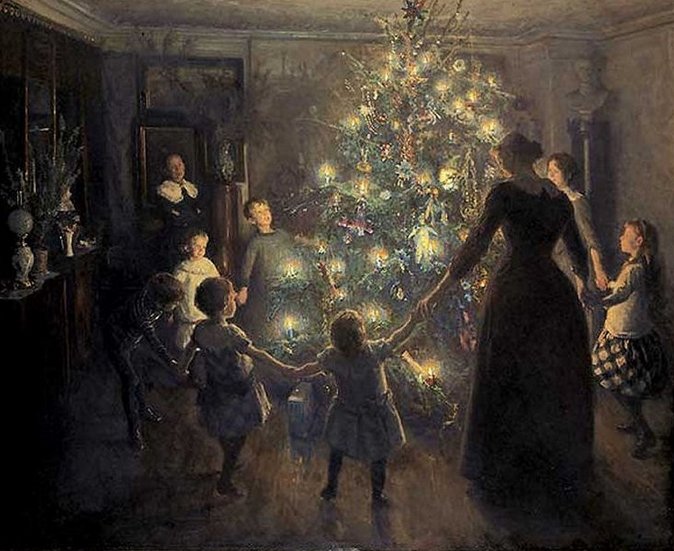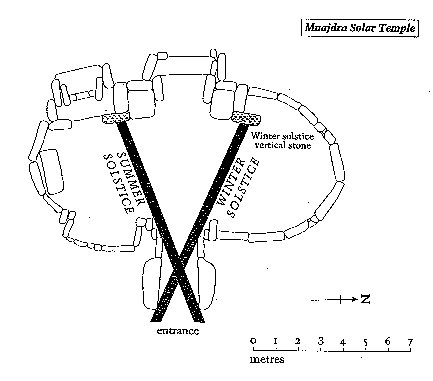Earlier I thought such a rakau (tree) glyph as that in Ca4-20 marked a very bright star, but after having improved my RA positions it is clear that Canopus ought to belong in the previous glyph, in St John's Day:
| June 22 |
23 (St John's Eve) |
24 (St John's Day) |
25 (176) |
|
December 22 |
23 |
24 |
25 (359) |
 |
 |
 |
 |
| Ca4-17 |
Ca4-18 (94) |
Ca4-19 |
Ca4-20 |
| te hau tea |
tupu te rakau - te henua |
te hau tea |
tupu te rakau |
| Al Han'ah-4 |
Furud (94.9) |
Well-22 |
no star listed (96) |
| TEJAT PRIOR (93.4), γ Monocerotis (93.5), κ Aurigae (93.6), κ Columbae (93.8) |
δ Columbae (95.2), TEJAT POSTERIOR, Mirzam (95.4), Canopus (95.6), ε Monocerotis (95.7), ψ1 Aurigae (95.9) |
| η Sagittarii (276.9) |
Kaus Medius, κ Lyrae (277.5), Tung Hae (277.7) |
Kaus Australis (278.3), ξ Pavonis (278.4), Al Athfar (278.6) |
Kaus Borealis (279.3) |
But Sirius remained at the greatest of these rakau glyphs:
| June 26 (177) |
27 |
28 |
29 (180) |
30 |
|
December 26 (360) |
27 |
28 |
29 |
30 (364) |
 |
 |
 |
 |
 |
| Ca4-21 |
Ca4-22 |
Ca4-23 |
Ca4-24 (100) |
Ca4-25 |
| ihe pepe rere |
ka rere ki tona nohoga |
te moko |
manu rere |
tupu te rakau |
| β Monocerotis (97.0) |
no star listed (98) |
ν Puppis (99.2), ψ3 Aurigae (99.4), ψ2 Aurigae Gemma
|
ψ4 Aurigae (100.5), Mebsuta (100.7) |
Sirius (101.2), ψ5 Aurigae (101.4), ν Gemini (101.6), ψ6 Aurigae (101.7) |
| ν Pavonis (280.4), κ Cor. Austr. (280.9) |
θ Cor. Austr. (281.0), Vega (281.8) |
no star listed (282) |
ζ Pavonis (283.4), λ Cor. Austr. (283.6), Double Double (283.7), ζ Lyrae (283.8) |
Φ Sagittarii (284.0), μ Cor. Austr. (284.6), η Cor. Austr., θ Pavonis (284.8) |
Metoro began to talk about the growth of this Tree at the beginning of line Ca4, at Gregorian day 314 / 2:
|
June 6 (157) |
7 |
8 |
|
December 6 (340) |
7 |
8 |
 |
 |
 |
|
Ca4-1 (77) |
Ca4-2 |
Ca4-3 |
| kua tupu te rakau |
kua tupu - te
kihikihi |
te hau tea |
|
μ Leporis (77.6) |
ĸ Leporis (78.0),
Rigel
(78.1), Capella
(78.4), ο
Columbae (78.8)
Thuban
|
λ Leporis (79.6)
Arcturus |
| Nodus
I (260.0), π Herculis (260.7), Ras Algethi (260.8) |
Sarin
(261.0), ο Ophiuchi (261.4)
Alrisha
|
ξ
Ophiuchi (262.2), θ Ophiuchi, ν Serpentis, ζ, ι Apodis (262.4), ι
Arae (262.8), ρ Herculis (262.9) |
I will therefore revise my earlier opinion about these rakau glyphs - with the exception of Sirius they do not mark the precise positions of very bright stars. Instead what seems to be illustrated is the gradual rise of a great 'Tree' (Rakau) - which could be a perception derived from numerous bright stars rising in succession like the illuminations in a Christmas tree. The heliacal stars of late June will be possible to observe in late December: 
|
June 6 |
7 |
10 |
June 18 |
19 |
20 |
21 (172) |
|
December 6 |
7 |
December 18 |
19 |
20 |
21 (355) |
 |
 |
 |
 |
 |
 |
|
Ca4-1 (77) |
Ca4-2 |
Ca4-13 |
Ca4-14 |
Ca4-15 |
Ca4-16 |
| kua tupu te rakau |
kua tupu - te
kihikihi |
kua tuu tona mea |
te henua |
te hau tea |
mauga hua - te henua |
| 3 |
June 25 |
26 (177) |
27 |
28 |
29 (180) |
| December 25 |
26 (360) |
27 |
28 |
29 |
 |
 |
 |
 |
 |
| Ca4-20 |
Ca4-21 |
Ca4-22 |
Ca4-23 |
Ca4-24 (100) |
| tupu te rakau |
ihe pepe rere |
ka rere ki tona nohoga |
te moko |
manu rere |
| June 30 |
July 1 |
2 |
3 |
4 (185) |
| December 30 |
31 |
January 1 (366) |
2 |
3 |
 |
 |
 |
 |
 |
| Ca4-25 |
Ca4-26 |
Ca4-27 |
Ca4-28 |
Ca4-29 |
| tupu te rakau |
erua tamaiti |
kua vaha te mago erua |
| SIRIUS (101.2), ψ5 Aurigae (101.4), ν Gemini (101.6), ψ6 Aurigae (101.7) |
τ Puppis (102.2), ψ7 Aurigae (102.4) |
ψ8 Aurigae (103.2), Alhena (103.8), ψ9 Aurigae (103.9) |
Adara (104.8) |
ω Gemini (105.4), Alzirr (105.7), Muliphein (105.8) |
| Φ Sagittarii (284.0), μ Cor. Austr. (284.6), η Cor. Austr., θ Pavonis (284.8) |
Sheliak, ν Lyrae (285.1), λ Pavonis (285.7) |
Ain al Rami (286.2), δ Lyrae (286.3), κ Pavonis (286.5), Alya (286.6) |
ξ Sagittarii (287.1), ω Pavonis (287.3), ε Aquilae, ε Cor. Austr., Sulaphat (287.4), λ Lyrae (287.7), Ascella, Bered (Ant.) (287.9) |
Nunki (288.4), ζ Cor. Austr. (288.5), Manubrium (288.8), ζ Aquilae (288.9) |
... World trees are a prevalent motif occurring in the mythical cosmologies, creation accounts, and iconographies of the pre-Columbian cultures of Mesoamerica. World trees embodied the four cardinal directions, which also serve to represent the four-fold nature of a central world tree, a symbolic axis mundi which connects the planes of the Underworld and the sky with that of the terrestrial realm ...
Among the Maya, the central world tree was conceived as or represented by a ceiba tree, and is known variously as a wacah chan or yax imix che, depending on the Mayan language. The trunk of the tree could also be represented by an upright caiman, whose skin evokes the tree's spiny trunk ...
World trees are frequently depicted with birds in their branches, and their roots extending into earth or water (sometimes atop a 'water-monster', symbolic of the underworld). The central world tree has also been interpreted as a representation of the band of the Milky Way.
Auriga, with the hairy goats on his back, holds a 'tree' which is marked out in the night sky by the 3 stars Praja-pāti (δ), Menkalinan (β), and Mahashim (θ):

| June 18 |
19 |
20 |
21 (172) |
|
December 18 |
19 |
20 |
21 (355) |
 |
 |
 |
 |
| Ca4-13 |
Ca4-14 |
Ca4-15 |
Ca4-16 (92) |
| kua tuu tona mea |
te henua |
te hau tea |
mauga hua - te henua |
| η Leporis (89.0), Praja-pāti, Menkalinan, Mahashim, and γ Columbae (89.3), η Columbae (89.7) |
μ Orionis (90.3), χ² Orionis (90.5) |
6h (91.3) |
ξ Orionis (92.5) |
| ν Orionis (91.4), θ Columbae (91.5), π Columbae (91.6) |
| ζ Serpentis (272.4), τ Ophiuchi (272.9) |
18h (273.4) |
Zhōngshān (274.0), π Pavonis (274.6) |
ι Pavonis (275.1), Polis (275.9) Menkar
|
| Nash (273.7), θ Arae (273.8) |
Metoro noted the Easter Island variant of the World Tree, the Toromiro, when in December Rigel and Capella were in the night sky, when it was midsummer:

|
December 5 |
6 |
7 |
8 (342) |
|
June 5 |
6 (157) |
7 |
8 (525) |
 |
 |
 |
 |
| Ca10-4 |
Ca10-5 (260) |
Ca10-6 |
Ca10-7 |
| te kiore - te
inoino |
kua oho te rima kua
kai - ihe nuku hoi |
Tupu te toromiro |
kua noho te vai |
|
Mula-19 |
Nodus I (260.0), π
Herculis (260.7), Ras Algethi (260.8) |
Sarin (261.0), ο
Ophiuchi (261.4)
Alrisha
|
ξ Ophiuchi (262.2), θ
Ophiuchi, ν Serpentis, ζ, ι Apodis (262.4), ι Arae (262.8), ρ
Herculis (262.9) |
|
Sabik (259.7),
η SCORPII
(259.9) |
|
5h (76.1) |
μ Leporis (77.6) |
ĸ Leporis (78.0),
Rigel (78.1), Capella (78.4), ο
Columbae (78.8)
Thuban
|
λ Leporis (79.6)
Arcturus |
| ε
Leporis (76.0), Cursa (76.4), λ Eridani (76.7) |
... At midsummer there is a
'marriage' between Spring Sun and Earth. He has grown up to
a maximum of power and his rays are ready to fertilize
Earth. Graham Hancock has in his Underworld, Flooded
Kingdoms of the Ice Age, given us an account of how it
could have been:
...
Then I become
aware of ... a presence - a faint, ghostly glimmering, like
moonglow, that has appeared on the solstice stone. I don't
know how long it lasts, a second or two only I would guess,
but while it is there it seems less like a projection -
which I know it to be - than something immanent within the
stone itself. And it seems to function as a herald for it
fades almost as soon as it has appeared and in its place the
full effect snaps on - instantaneously. It wasn't there, and
then it's there.
As Chris had
described, the effect does curiously resemble a poleaxe, or
a flag on a pole, and consists of a 'shaft', narrow at the
base but widening a little towards the top, running up the
left hand side of the solstice stone, surmounted by a
right-facing 'head' or 'flag'. An instant later an
almond-shaped spot of light, like an eye, appears a few
centimeters to the right of the 'flag' and the effect is
complete.
Weirdly - I do
not claim it has any significance - this flag-on-a-pole
symbol is the ancient Egyptian hieroglyph neter,
meaning 'god', or 'a god' - and not to be understood at all
in the Judaeo-Christian usage of that word but rather as a
reference to one of the supernatural powers or principles
that guide and balance the universe. Manifested here, in
this strange Stone Age temple, it glows, as though lit by
inner fire.'
The Mnajdra Temple
is located on Malta and very ancient, dating to the time
before the pyramids. Marija Gimbutas: 'To sleep within the
Goddess's womb was to die and to come to life anew'.
In a system of reincarnation
the old one must die in order to be reborn, of course. At
midsummer Sun comes to a standstill, and this must therefore
be an occasion when the 'flame of life' had to be
transported into a new body ...
|
|












